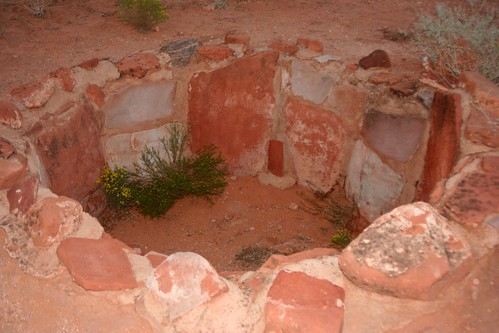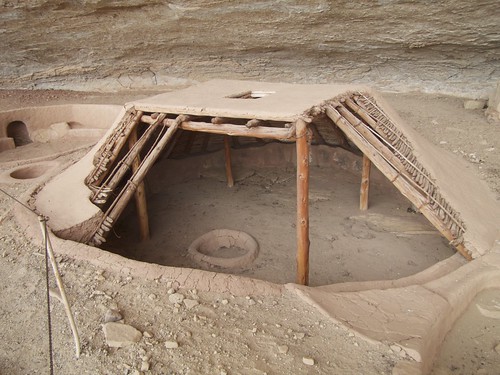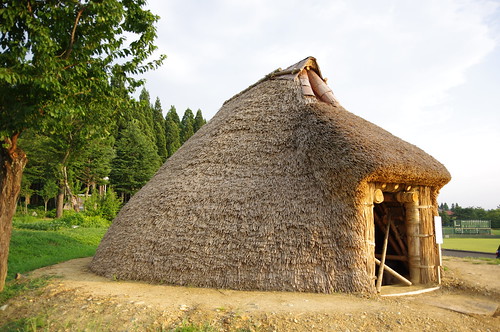Whether in homes or greenhouses, partially buried buildings (pit-houses, dugout shelters) benefit from thermal stability and the heating and cooling of the earth, thus facilitating the lives of people and plants in areas with high-temperature variation, unexpected weather events.
Increasingly used as greenhouses, benefiting from internal microclimates close to thermal comfort levels, equally appropriate both for hosting crops and for sheltering people and animals: they achieve a sense of warmth in winter and coolness in summer without using energy sources beyond those already present in the surrounding subsoil.
Taking advantage of the constant temperature of the earth
In partially buried buildings, the interior temperature remains constant and equal to the local average annual temperature of the air. This is possible thanks to the thermal inertia of the part of the building that is situated below the level of the ground, whose temperature lags several months behind the external air temperature, thus avoiding the effects of large changes such as snow, ice, heat waves, etc.
Thus, there is a way to prevent the interior of a building from registering abrupt changes in the temperature of the external atmosphere, and this is well-known to many distinct cultures: to avoid abrupt changes in temperature, it is sufficient to locate the floor of the building at greater depth in the soil (and therefore at a greater distance from the surface).
Environmental designs: from optional luxury to necessary technique
Partially buried buildings use simple construction methods, but yield immediate returns. Their age-old benefits have become relevant again, now that both environmental considerations and protection from extreme climatic phenomena have become a priority, as a result of events such as Hurricane Sandy.
http://www.flickr.com/photos/marielle/2962703372/
The partially buried surface of these structures protects as much from snow, ice, and frosty nights as from scorching heat, by benefiting from the constant temperature (the thermal mass) of the subsoil, and of which stored food (which is better preserved), planted crops (if the building is a greenhouse), and human inhabitants of regions with inhospitable climates can all take advantage.
The ancient relationship with partially buried buildings
This would explain their popularity among peoples who settled themselves in especially demanding climates, and who preserved techniques for building structures with their bases below the level of the ground:
- from the Native Americans of the Southwest desert of the United States, the Anasazi, who endured high temperatures, or those peoples of the Andean Altiplano, who faced extreme daily temperature variations;
- to people who protected themselves from the cold and preserved their food with similar buildings: the Saxons of Europe (who constructed “Grubenhäuser”), the archaic Jōmon culture of Japan, or the Inuit of the Arctic.
If the partially buried buildings of northern European peoples succumbed to the canons of construction recommended by Rome, and if during the Age of Discovery the Eurocentric construction materials and technologies were imposed worldwide, first in buildings of worship and government, and in the homes of officials and settlers, then later in the homes of the conquered peoples.
Nevertheless, the methods for constructing partially buried houses, with gabled roofs executed using local techniques and materials, survived in remote places as disparate as the Carpathians (where these buildings were called “burdei”), Friesland (the aforementioned “Grubenhaus” of coastal Holland, Germany, and Denmark), the southwestern United States, and the Arctic Circle.
The Hitzacker Archeological Center, located in the Lower Saxony region of Germany, is an anthropological museum with a representation of traditional settlements present in the area since the Bronze Age: huts with a single room (Wohnstallhäuser), communal houses similar to those of the Vikings (Langhäuser), covered tombs (Totenhütte), and partially buried houses (Grubenhäuser).
The ancient geographic spread of these buildings was very wide. A comparative analysis of 862 societies worldwide shows how 82 of these peoples used -and occasionally still use- partially buried structures as houses, barns, stables, or workspace.
According to the Ethnographic Atlas of anthropologist George Peter Murdock, of the 82 societies familiar with the construction of dwellings with surfaces below the level of the ground, all but six live above 32 degrees north latitude, which marks the climate border of North America and Eurasia, thus including all of Europe and the present United States and Canada.
Not surprisingly, of the remaining six societies, four developed this construction technique in order to benefit from the constant thermal mass of the ground, while living in regions of high mountains, with great thermal variations, in central Africa and the highest zones of Paraguay and the east of Brazil.
The rustic simplicity of the essential
Partially buried buildings are found among the most common human shelters and are present in disparate cultures, and, therefore, are close to the simple but practical minimalism of those spaces that are blind to the inessential.
The classical architect, Marcus Vitruvius, considered the “primitive hut” to be the building closest -in his opinion- to the most elevated architectural expression: the classical Greek building.
The peoples of North Africa (Tunisia, for example), Mediterranean Europe, Anatolia (Cappadocia), the Fertile Crescent, and the Loess Plateau (China) took advantage of the terrain, the properties of the soil (clay, sandstone, limestone, siltstone, etc.), and limited rainfall in order to excavate whole houses in the form of caves.
On underground architecture
Underground architecture shares the majority of the advantages of partially buried buildings but requires more work and maintenance; in these places, still today, cave dwellings are a testament to the benefits of ancient bioclimatic architecture.
Conversely, partially buried buildings share the bioclimatic benefits of cave dwellings, but without their inconvenience, in not requiring the same effort for construction and maintenance, and also not requiring particular types of limestone or sedimentary rock in order to make construction feasible.
Some of the benefits of traditional bioclimatic buildings, whether partially buried or fully underground, with respect to conventional buildings are:
- savings on insulating material (unnecessary because of the benefits of the constant thermal mass of the subsoil), energy, and, therefore, emissions;
- protection against hurricane-force winds and earthquakes, especially true for structures with roofs that are partially or completely buried;
- harmonious integration of dwelling and landscape, which saves material, has less impact, and imitates the relationships already found in the patterns of nature.
Concerning excessive humidity and gases from the subsoil
Among the disadvantages of such buildings, the most prominent is the high level of humidity in the interior of the space, which can actually be an advantage when a partially buried building is used as a greenhouse, but which constitutes a problem when it is used as housing.
The humidity and excessive condensation can be countered, in both partially and fully buried houses, with adequate ventilation.
However, the accumulation of radon (a radioactive chemical element, difficult to detect because it is colorless, odorless, and tasteless), is more difficult to control, especially in buildings completely buried under the earth.
Because of the inconvenience and health concerns inherent in elevated levels of humidity and the incidence of difficult-to-detect gases, such as radon, in the subsoil, partially buried buildings provoke greater interest among small agricultural producers.
Plant in early spring in cold regions
Before the spread of intensive agriculture, one of the most widely used agricultural practices in the high latitudes and high mountain regions of northern Europe, was to plant a crop of vegetables for their own consumption in early spring, in holes about 1 meter (3 feet) deep.
The hole was then covered with several -at least three- layers of organic substances:
- the lowest layer contained animal manure (e.g. from horses);
- the middle layer contained humus (topsoil) from the surface;
- the third layer, closest to the surface, was left free for the growth of the plant, or incorporated straw, fermented leaves, or light, decayed materials of a similar nature.
Finally the opening was protected from the environment, which was still cold and prone to morning frosts, by a wood-framed glass cover, which allowed the plants to take advantage of the concentrated heat supplied by the thermal mass of the ground, the heat released by the the animal manure, and the heat from the solar radiation coming through the glass.
At the same time, the soil around the hole acted as a passive heat sink for the solar energy of the early spring, capturing it during the day and releasing it during the night.
Ancient techniques as tools for the future
Farmers and aficionados alike seek to revive and refine similar subsistence techniques and make them the basis of an intensive agriculture of the future: bioclimatic, affordable, and making use of the natural cycles of integrated farms where animal and plant wastes become valuable inputs enriching the process, rather than hazardous materials.
In the United States and northern Europe, greenhouses are proliferating with their bases set below ground level, in order to be able to plant at a constant ambient temperature, without using any more energy than that provided by the thermal inertia of the soil itself.
The cultivated pits of Lanzarote
In some parts of the Canary archipelago such as the island of Lanzarote, human ingenuity permitted the cultivation of fruit trees and vegetables on barren volcanic terrain, plagued with stony ground, despite strong winds and erosion of the land.
Like the rest of the Canaries, Lanzarote was self-sufficient, and even allocated part of its production for export to privateers from Britain, Holland, and the Thirteen Colonies of North America (i.e. the future United States), among others, thanks to cultivation in open pits in huge sandy areas, protected on the surface by stone walls.
In 1730, the island suffered a strong eruption of the volcano Timanfaya that destroyed the island’s potential for cultivation, which was recovered some decades later, after breaking the stony ground with only the help of draft animals.
Partially buried greenhouses and organic farms
The partially buried greenhouse has been transformed from its origins as a structure for subsistence agriculture into a center of intensive production employing bioclimatic and, recently, organic methods, and using integrated agricultural management models, in which animals are range fed, without recourse to supplementary feed, and in which their wastes fertilize the fields. In this model waste becomes food.
Whether used as a house or as a greenhouse, any partially buried building with a gabled roof can follow a methodology that has not varied in any significant way since the Saxons first erected their “Grubenhäuser”.
Underground greenhouses today
Among the most reliable designs, the following stand out:
- the design for the mountainous regions of Idaho along the U.S. border with Canada, proposed by Mike Oehler in his essay on the subject;
- and the Walipini system for partially buried greenhouses, proposed by the Benson Institute in Provo, Utah.
Mike Oehler was interested in bioclimatic greenhouses with floors below ground level after trying to grow conventional crops in the mountains of Idaho bordering Canada, where the frost-free growing season is only 90 days long.
During years of testing, in which crops of tomatoes and corn succumbed to the first frosts of September, and even varieties of Swiss chard and cabbage died in October, Oehler, an occasional visitor to the region, decided to consult his neighbors who were native to the area.
Their advice: if he would have crops that endure all year round, in such a demanding mountain climate, he must opt in general for tubers and root crops -onions, garlic- that he could plant in what they called “root cellars”.
Root cellars
In using this term “root cellar” Oehler’s neighbors were referring to small greenhouses whose planting beds were situated below ground level, and which, therefore, had a surrounding thermal mass that reflected the average temperature of the area as measured for the entire year, instead of the ambient temperature of the moment.
Moreover, the tubers took more efficient advantage of the thermal phenomena in the subsoil by concentrating all their growth in the roots: the part buried below the planting bed, in the frost-free part of the partially buried greenhouse.
Soon Oehler saw how other crops with varieties adapted to cold and the high mountains -pumpkins and apples- could also flourish briskly in his “root cellar” or partially buried greenhouse.
Finally, eager to cultivate all kinds of crops throughout the year, Mike Oehler says: “I built a small growing pit, and it worked“, but the first model needed some improvements.”
Because of local conditions (low temperatures, large thermal differences between day and night), Oehler could only remove the small glazed cover in order to water, move soil, or pull weeds on days when the ambient temperatures were 40F or greater, which undermined the orderly progression of his harvests.
Another design error lay in the horizontal placement of the glass cover over the pit: when the rays of the sun struck the glass at a low angle, as occurs in early spring at the latitude of the U.S.-Canadian border (the latitude of France, in Europe), the majority of the rays are reflected without being absorbed, much like a stone skipping off the surface of a lake.
Improving on the fly: the advantages of spacious, inclined habitats
Given the accumulated experience with the advice of his neighbors and his own domestic experiments and investigations, Mike Oehler perfected the design of his partially buried greenhouse, converting it into a structure with enough covered space to permit working comfortably with the plants from the interior of the building; and with a pitched roof to facilitate the penetration of solar radiation when that was necessary.
Without being aware of it, Mike Oehler had rediscovered an ancient design for partially buried buildings, known to diverse cultures around the world that were exposed to the climatic demands of high latitudes, high mountains, or both.
He concluded that partially buried greenhouses would permit the cultivation of all types and varieties of fruits and vegetables, despite the harsh temperatures of some seasons or hours of the day, and he determined to counter these limitations with several complementary techniques.
- The use of thermal inertia, and the protection derived from planting below ground level;
- the heat released from animal manure;
- and the solar radiation trapped by the glazed, pitched roof.
The “warm shelters” of the Aymara
The Benson Institute, located in the city of Provo in the state of Utah, which is both arid and prone to abrupt temperature changes, has perfected, over more than two decades, its own design for partially buried greenhouses, which are called Walipini, from the Aymara word for “warm shelter”.
The technique allows the cultivation of fruits and vegetables, even at altitudes above 4,000 meters, in remote villages in the Andes.
Like the design of Mike Oehler, the greenhouses that adopt the Walipini approach can be erected at little cost in any hostile climate, and can obviate the effects of such climates, including frosts and abrupt thermal variations, with buildings whose surfaces benefit from the constant temperature of the earth, combined with the concentrated radiation of the sun striking the roof.
Designs for transportable and economic partially buried greenhouses
Walipini greenhouses use surfaces made of materials such as transparent plastic polymers (polycarbonate, etc.) that are permeable to solar radiation, but that are cheaper, lighter, easier to transport, and easier to replace than glass.
The panels are situated on the surface of the building with the proper angle to optimize the incidence of the rays of the sun at the moment when the sun is closest to the horizon and therefore weakest, which is to say at the winter solstice (21 December in the northern hemisphere, or 21 June in the southern).
Designs like those of Mike Oehler and the Benson Institute demonstrate the simplicity, adaptability, and affordability of bioclimatic greenhouses.
Anyone can build their own partially buried greenhouse, where plants can obtain the constant temperature of the earth, guaranteeing warmth in winter and coolness in summer, with respect to the ambient external temperatures. Builders can also preserve food without the need of either electricity or electric appliances, conserve wines and sparkling beverages, or shelter humans and animals, if the buildings are adapted for that.
Build your own subsurface greenhouse
What better hymn to productive rural leisure (otium ruris), praised by Seneca and Virgil, among others, than to plan a greenhouse for oneself as part of a system of food production, and for the transformation of waste into “rich foods”.
In a farm -large or small- that is integrated according to the the natural cycle of pastoral management, (as is described by Michael Pollan in his essay The Omnivore’s Dilemma in referring to the southern farmer Joel Salatin, owner of the Polyface organic farm) the word “waste” loses its semantic value, since a “cost” in one part of the cycle is “food” in another.
An “obsolete technology” with a big future
Partially buried greenhouses are another of the ancient opportunities waiting to be rescued from the drawer labeled “outdated technologies”.
Few “obsolete” agricultural techniques hold so much promise for the future, argue those who have used it: suitable for organic cultivation on farms of various sizes, and therefore also suitable in urbanbioclimatic applications, and also compatible with the patterns of nature (as in the practices of permaculture).
And with limited impact, in not requiring more energy than already found in the thermal inertia of the ground, the heat released by animal manure, and the radiation captured by filtering the rays of the sun.
[This article was translated -and improved- into English by our friend David Johnson from the original Spanish; hard for us not to credit your excellent work, David “Sue D. O’Nimm”]



